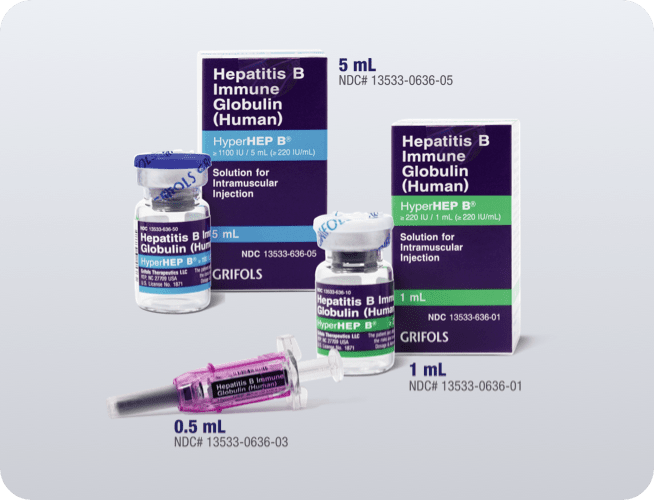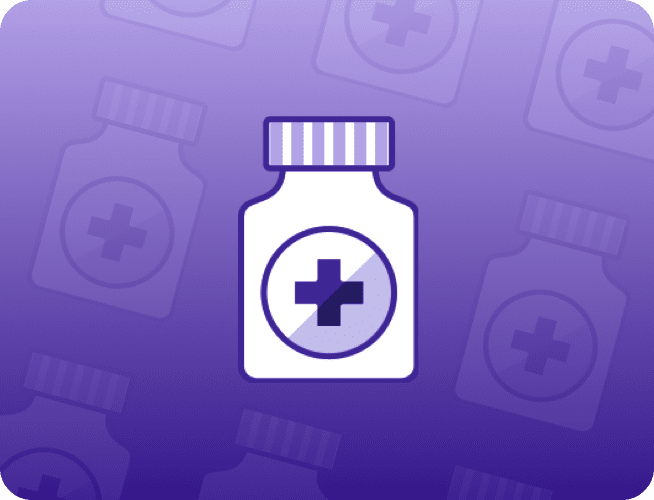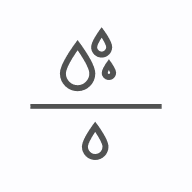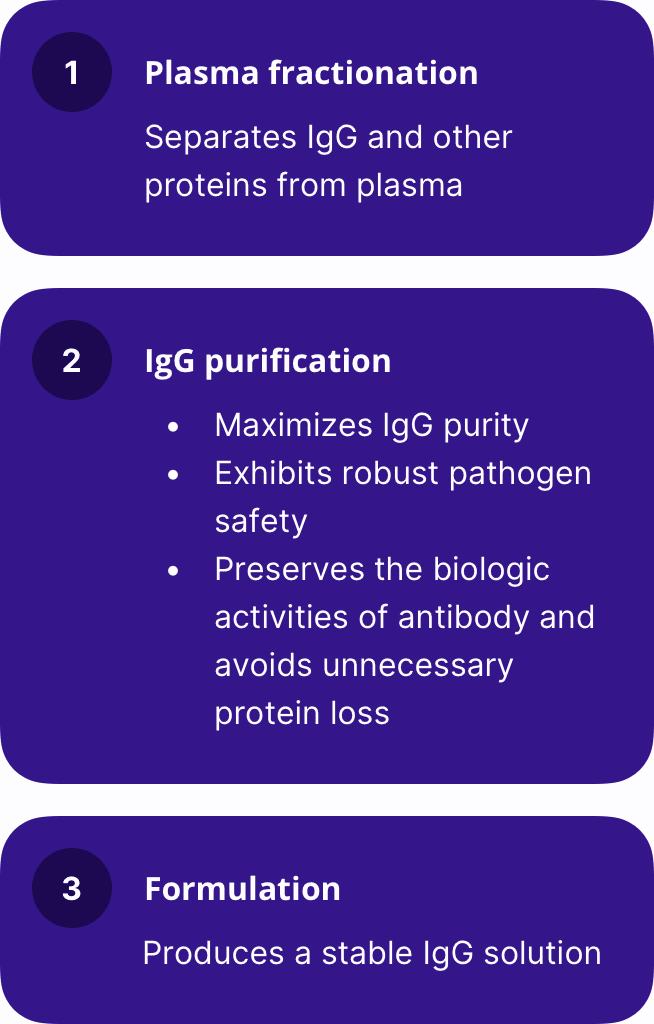Treating With HyperHEP B
HyperHEP B is an immunoglobulin that provides rapid immune coverage.1 Vaccines can provide lifelong protection but take weeks to build efficacy, however, HyperHEP B provides immediate protection that allows the vaccine the time needed to establish active immunity in high-risk situations.1-3
HyperHEP B contains high titers of antibodies, equivalent to or exceeding the potency of anti-HBs in a US reference hepatitis B immune globulin standard (established by the Center for Biologics Evaluation and Research, FDA), and provides rapid immune protection for postexposure prophylaxis (PEP).1,2
Trusted Dependability
- Established history—more than 45 years of consistent supply and product support
- Not made with mercury (thimerosal) or natural rubber latex
- Unique multi-step purification process
- US Food and Drug Administration (FDA) labeling for capacity to remove pathogenic prions
- Only hepatitis B immune globulin product in a convenient prefilled syringe specifically for neonatal administration1,4,5


Acute Exposure to Blood Containing HBsAg
Hepatitis B virus (HBV) infection can develop after either parenteral exposure (eg, by accidental needlestick), direct mucous membrane contact (eg, accidental splash), or oral ingestion (eg, pipetting accident) involving hepatitis B surface antigen (HBsAg)-positive materials such as blood, plasma, or serum.

Perinatal Exposure of Infants Born to HBsAg-Positive Mothers
Infants born to HBsAg-positive mothers are at risk of being infected with HBV and becoming chronic carriers. This risk is especially high if the mother is hepatitis B e-antigen (HBeAg)-positive.

Sexual Exposure to an HBsAg-Positive Person
Sex partners of HBsAg-positive persons are at increased risk of acquiring HBV infection.

Household Exposure to Persons With Acute HBV Infection
Because infants have close contact with primary caregivers and have a higher risk of becoming HBV carriers after acute HBV infection, prophylaxis treatment of an infant less than 12 months of age with HyperHEP B and hepatitis B vaccine is indicated if the mother or primary caregiver has acute HBV infection.
Clinical Efficacy
Immediate Protection With HyperHEP B1,3
The vaccine alone is not enough: immune globulins like HyperHEP B, when used in combination with a vaccine, can prevent infection by hepatitis B. The administration of the recommended dose of this immune globulin generally results in a detectable level of circulating anti-HBs, which persists for approximately 2 months or longer.
Acute Exposure to Blood Containing HBsAg1
- For inadvertent percutaneous exposure, a regimen of 2 doses of HyperHEP B—1 given after exposure and 1 a month later— is about 75% effective in preventing hepatitis B in this setting
Perinatal Exposure of Infants Born to HBsAg-Positive Mothers1
- For an infant with perinatal exposure to an HBsAg-positive and HBeAg-positive mother, a regimen combining 1 dose of HyperHEP B at birth with the hepatitis B vaccine series started soon after birth is 85% to 95% effective in preventing development of the HBV carrier state
- Regimens involving either multiple doses of HyperHEP B alone or the vaccine series alone have 70% to 90% efficacy, while a single dose of HyperHEP B alone has only 50% efficacy
Sexual Exposure to an HBsAg-Positive Person1
- For sexual exposure to a person with acute hepatitis B, a single dose of HyperHEP B is 75% effective if administered within 2 weeks of last sexual exposure
Always a leader. Always dependable.
Grifols has provided more than 45 years of consistent supply and product support.
HyperHEP B offers1,6:
- A product that is preservative free and not made with mercury (thimerosal) or natural rubber latex
- U.S. Food and Drug Administration (FDA) labeling for capacity to remove pathogenic prions
- Low procoagulant activity
- Low levels of immunoglobulin G (IgG) aggregates
- Tamper-evident packaging

Proven virus clearance capacity1
HyperHEP B is produced using a sophisticated caprylate/chromatography purification process that employs the highest quality and safety standards.
Main steps of the manufacturing process:

Caprylate precipitation

Depth filtration

Nanofiltration

Caprylate incubation

Low pH final container incubation

Column chromatography
The capacity of the HyperHEP B manufacturing process to remove and/or inactivate viruses has been demonstrated by laboratory spiking studies on a scaled-down process model using a wide range of viruses with diverse physicochemical properties. This process provides the final product with a high margin of safety from the potential risk of transmission of infectious viruses.
The caprylate/chromatography manufacturing process was also investigated for its capacity to decrease the infectivity of an experimental agent of transmissible spongiform encephalopathy (TSE), considered as a model for the variant Creutzfeldt-Jakob disease (vCJD) and Creutzfeldt-Jakob disease (CJD) agents. These studies provide reasonable assurance that low levels of vCJD/CJD agent infectivity, if present in the starting material, would be removed by the caprylate/chromatography manufacturing process.
How the unique HyperHEP B manufacturing process works

HyperHEP B is made from human blood and may carry a risk of transmitting infectious agents, eg, viruses, the vCJD agent, and, theoretically, the CJD agent.
Traceability and Transparency of Information
Grifols' manufacturing process has a comprehensive computer system called PediGri® that ensures full traceability from every donation
- Each plasma unit is coded and computer-traced from the start of the process until the units are transformed into a final product
- Users can access the donation number and the viral screening conducted at the origin of the donation with the product lot number
- Specific information is also available, including the total number of plasma units, the total volume of plasma, the certificate of analysis showing the plasma origin viral screening, and biochemical characteristics of the final product
- Users can access the applicable product SPC/package insert for their country
For immediate, easy, and convenient access to all the information on the origin and quality of Grifols' plasma derivatives, visit www.pedigri.grifols.com.
Dosing Recommendations for HyperHEP B1
Exposure to blood containing HBV
- Dosage
-
0.06 mL/kg IM as soon as possible after exposure and within 24 hours
Infants born to mothers who carry HBV
- Dosage
-
0.5 mL IM after physiologic stabilization and preferably within 12 hours of birth
Sexual contact with persons who carry HBV
- Dosage
-
0.06 mL/kg IM within 14 days of last sexual contact with infected person
All other contacts
- Dosage
-
See complete Prescribing Information
| Indication | Dosage |
|---|---|
|
Exposure to blood containing HBV |
0.06 mL/kg IM as soon as possible after exposure and within 24 hours |
|
Infants born to mothers who carry HBV |
0.5 mL IM after physiologic stabilization and preferably within 12 hours of birth |
|
Sexual contact with persons who carry HBV |
0.06 mL/kg IM within 14 days of last sexual contact with infected person |
|
All other contacts |
See complete Prescribing Information |
Coding Information
Product CPT Code*
- Coding for HyperHEP B
-
90371
- Description
-
Hepatitis B immune globulin (HBIG), human for intramuscular use (1 mL)
Administration Procedures CPT Code*
- Coding for HyperHEP B
-
96372
- Description
-
Therapeutic, prophylactic, or diagnostic injection (specify substance or drug); intramuscular
ICD-10-CM†
- Coding for HyperHEP B
-
B19.1
- Description
-
Unspecified viral hepatitis B
Product NDC‡
- Coding for HyperHEP B
-
13533-0636-03
- Description
-
0.5-mL syringe
| Coding System | Coding for HyperHEP B | Description |
|---|---|---|
|
Product CPT Code* |
90371 |
Hepatitis B immune globulin (HBIG), human for intramuscular use (1 mL) |
|
Administration Procedures CPT Code* |
96372 |
Therapeutic, prophylactic, or diagnostic injection (specify substance or drug); intramuscular |
|
ICD-10-CM† |
B19.1 |
Unspecified viral hepatitis B |
|
B19.10 |
Unspecified viral hepatitis B without hepatic coma |
|
|
B19.11 |
Unspecified viral hepatitis B with hepatic coma |
|
|
B18.1 |
Chronic viral hepatitis B without delta-agent |
|
|
B18.0 |
Chronic viral hepatitis B with delta-agent |
|
|
B18.9 |
Chronic viral hepatitis, unspecified |
|
|
B18.8 |
Other chronic viral hepatitis |
|
|
B17.0 |
Acute delta-(super) infection of hepatitis B carrier |
|
|
B16.0 |
Acute hepatitis B with delta-agent with hepatic coma |
|
|
B16.9 |
Acute hepatitis B without delta-agent and without hepatic coma |
|
|
B16.1 |
Acute hepatitis B with delta-agent without hepatic coma |
|
|
B16.2 |
Acute hepatitis B without delta-agent with hepatic coma |
|
|
Z20.5 |
Contact with and (suspected) exposure to viral hepatitis |
|
|
P39.9 |
Infection specific to the perinatal period, unspecified |
|
|
Z20.2 |
Contact with and (suspected) exposure to infections with a predominantly sexual mode of transmission |
|
|
Product NDC‡ |
13533-0636-03 |
0.5-mL syringe |
|
13533-0636-01 |
1-mL vial |
|
|
13533-0636-05 |
5-mL vial |
Important Safety Information for HyperHEP B® (hepatitis B immune globulin [human])
HyperHEP B® (hepatitis B immune globulin [human]) is indicated for postexposure prophylaxis in the following situations: acute exposure to blood containing HBsAg, perinatal exposure of infants born to HBsAg-positive mothers, sexual exposure to an HBsAg-positive person, and household exposure to persons with acute HBV infection.
HyperHEP B should be given with caution to patients with a history of prior systemic allergic reactions following the administration of human immunoglobulin preparations. Epinephrine should be available.
In patients who have severe thrombocytopenia or any coagulation disorder that would contraindicate intramuscular injections, hepatitis B immune globulin (human) should be given only if the expected benefits outweigh the risks.
Local pain and tenderness at the injection site, urticaria, and angioedema may occur; anaphylactic reactions, although rare, have been reported following the injection of human immunoglobulin preparations. Administration of live virus vaccines (eg, MMR) should be deferred for approximately 3 months after hepatitis B immune globulin (human) administration.
HyperHEP B is made from human plasma. Products made from human plasma may contain infectious agents, such as viruses, and, theoretically, the Creutzfeldt-Jakob disease (CJD) agent that can cause disease. There is also the possibility that unknown infectious agents may be present in such products.
Please see full Prescribing Information for HyperHEP B.
You are encouraged to report negative side effects of prescription drugs to the FDA. Visit www.fda.gov/medwatch or call 1-800-FDA-1088.
References
- HyperHEP B® (hepatitis B immune globulin [human]) Prescribing Information. Grifols.
- Baxter D. Active and passive immunity, vaccine types, excipients and licensing. Occup Med (Lond). 2007;57(8):552-556.
- Centers for Disease Control and Prevention. Hepatitis B. In: Hall E, Wodi AP, Hamborsky J, Morelli V, Schillie S, eds. Epidemiology and Prevention of Vaccine-Preventable Diseases. 14th ed. Washington, DC. Public Health Foundation; 2021.
- HepaGAM Prescribing Information. Kamada Pharma, 2022.
- Nabi HB Prescribing Information. ADMA Biologics, 2019.
- Data on file, Grifols.